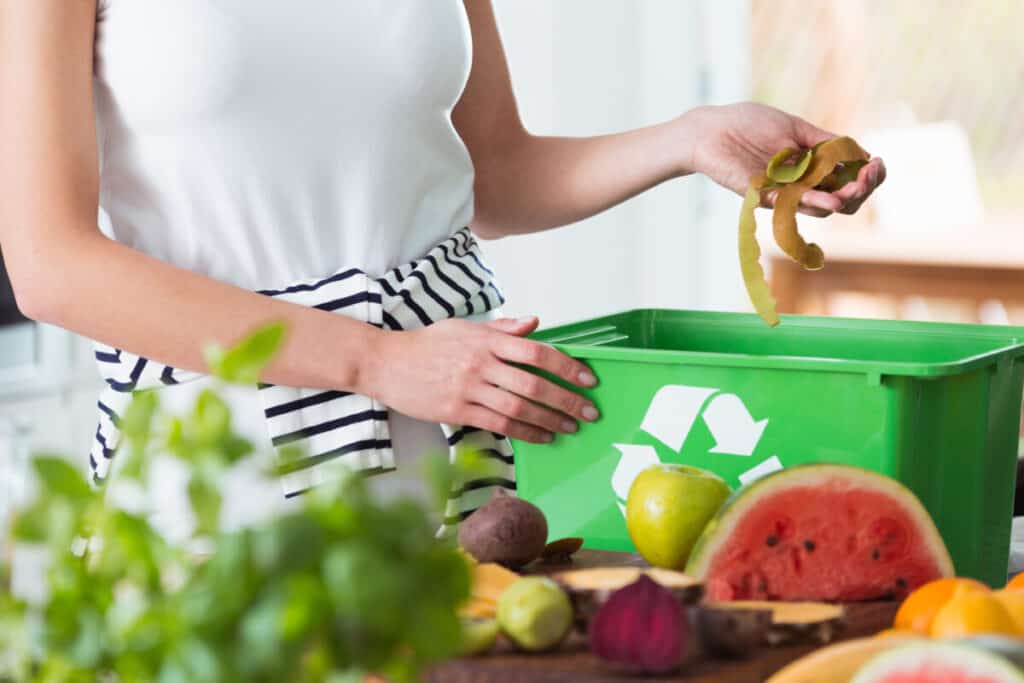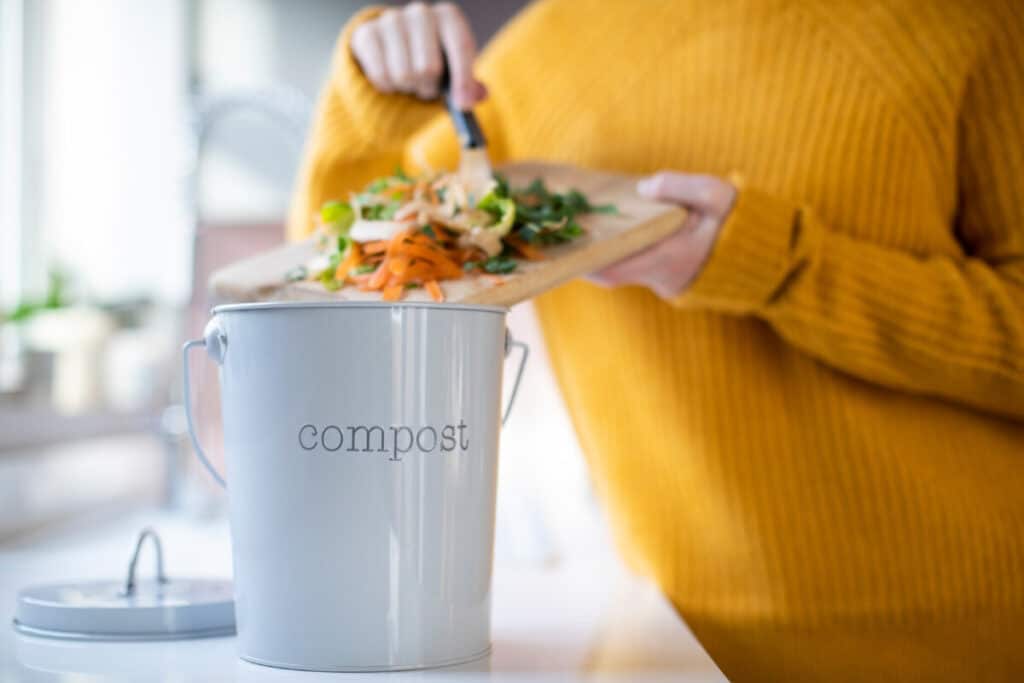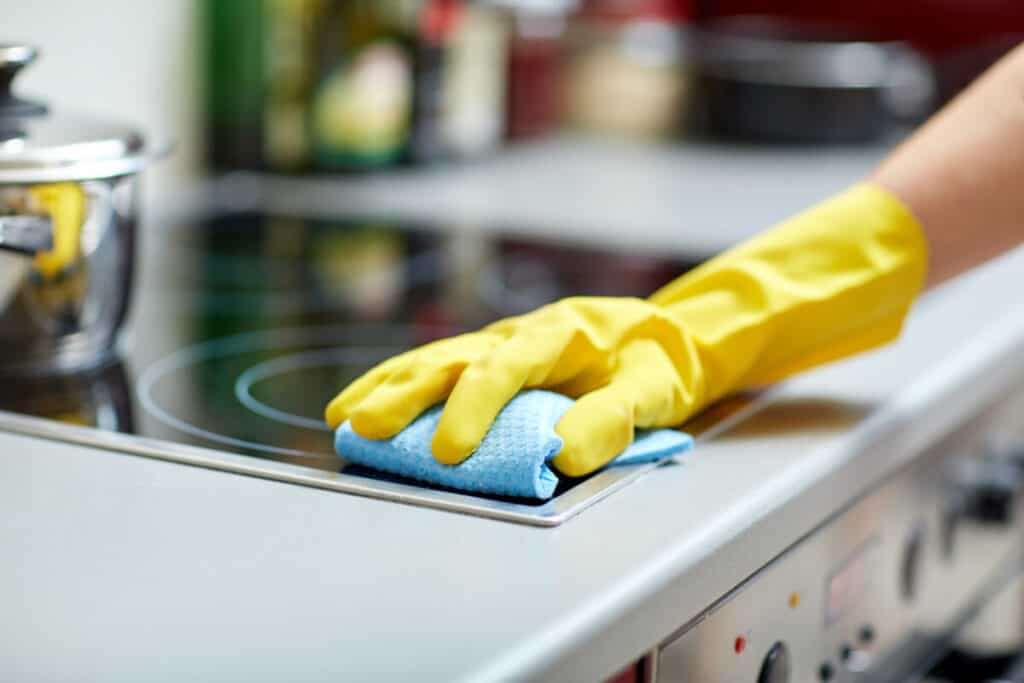
Kitchen waste is often tossed out into landfills and left to rot and create toxic gasses that do nothing for our environment. Kitchen waste can be broken down into two categories: food waste and household hazardous waste.
Kitchen food waste can be recycled by composting via three basic ingredients: brown material such as dead leaves, or branches, green material such as vegetable or fruit scraps, and water. Household hazardous waste such as kitchen cleaning supplies and plastics can be recycled with proper disposal.
Let’s go over these options a bit more closely!
Why Recycle Food Waste
Food waste is the largest category that fills our landfills, producing methane gas as food decomposes. Methane is a powerful greenhouse gas and the solid waste within municipal landfills is the third-largest contributor to human-related methane emissions in the US.
Food waste includes safe and whole food that is tossed by businesses and households. This food can instead be donated to food banks or be distributed directly to families in need of food. Select food waste that is not whole or safe for human consumption can be composted.
Reducing food waste can also lighten a household’s trash pickup by keeping the food waste outside of the garbage as select places can reduce prices and even lower fees if food waste is separate from the trash heading to a landfill and is delivered to a composting facility. (source)
Researching what policies your local municipal waste management and reaching out to them about their programs can net many benefits for yourself and the environment.
Composting

Composting utilizes a natural process of decomposition to give nutrients back into the soil. It requires three simple ingredients to succeed.
- Brown material such as dead leaves, dry branches, and twigs.
- Green material such as grass clippings from your lawn, vegetable trimmings and clippings, fruit scraps, and coffee grounds
- Water
Brown and green material should be in equal amounts while water brings moisture to the mixture to help break down the organic matter. Alternating layers of different sizes of organic materials will aid in getting a rich variety of compost.
Brown materials provide carbon while green materials provide nitrogen – both of which aid new growth and bring needed nutrients to the compost.
What is Safe to Compost
- Fruits and vegetables
- Eggshells
- coffee grounds and filters
- Teabags
- Nutshells
- Shredded newspaper
- Yard trimmings
- House plants
- Cotton and Wool rags
- Hair and fur
- Fireplace ashes
- Leaves
- Cardboard
- Paper
What Is Not Safe to Compost
- Meat or fish bones or scraps
- Diseased or insect plagued plants
- Fats, grease, lard, or oil
- Pet and human waste
- Yard trimmings treated with chemical pesticides
- Coal or charcoal ash
- Black walnut tree leaves or twigs
These items in your compost pile can introduce bad odors, pests, and diseases into your compost and yard that are best to be avoided.
How to Compost at Home
Helpful tools for composting are pitchforks, square-point shovels or machetes, and water hoses that have a spray head attachment. Mixing or turning compost with the aid of water will help maintain your compost and let it evenly decay into rich soil.
Backyard Composting
- Find a place in your yard that is a dry, shady area for your compost pile or bin, far enough away that any potential odors as the compost are getting established will not bother you.
- Add brown and green materials as they’re collected and make sure to keep your establishing material small by either chopping or shredding it into small pieces.
- Add moisture to any dry materials when added by soaking them in water if possible.
- Once the compost pile is established, mix green waste into the pile – burying fruit and vegetable waste at least ten inches from the compost material.
Indoor Composting
Indoor composting is possible if you do not have the resources or space for an outdoor compost pile by using a special composting bin that can be purchased at your local hardware or gardening store. If properly managed, an indoor compost bin will not attract rodents and will not smell. (source)
Kitchen Cleaners and Recycling

Household cleaners can contain chemicals that are not appropriate for disposal down the drain, and thus can be considered household hazardous waste.
First, check the label on your cleaning supplies to see if there are any disposal instructions that have been specified. Check with your household hazardous waste facility to see if your cleaning products fall under the household hazardous waste and what to do to dispose of them.
A guideline for household cleaners in how to dispose of them is to think about what fashion they are used. If while cleaning, the product comes into contact with water as intended, it is generally considered safe to be disposed of down the drain.
Solid products, like soap scouring pads, scrubbers, and other solid cleaning supplies can be placed in the trash. For products that do not come in contact with water and may not be water-soluble, like oven cleaners, and furniture polishes, call or write the manufacturer for disposal recommendations or check with your local waste disposal facility.
If you are unsure, always check the label and with your local household waste facility to see if your product applies.
Kitchen Cleaning Alternatives
If you are genuinely worried about the impact household cleaning supplies can have on your environment once they are washed down the drain, here are some good alternatives to some common household cleaners:
| Drain Cleaner | Use a plunger or plumber’s snake |
| Glass Cleaner | Mix one tablespoon of vinegar or lemon juice in one quart of water. Spray on and use newspaper to dry. |
| Furniture Polish | Mix one teaspoon of lemon juice in one pint of mineral or vegetable oil and wipe the furniture. |
| Rug Deoderizer | Liberally sprinkle carpets with baking soda. Wait at least 15 minutes and vacuum. Repeat as necessary. |
| Silver Polish | Boil two to three inches of water in a shallow pan with one teaspoon of salt, one teaspoon of baking soda, and a sheet of aluminum foil. Totally submerge silver and boil for two to three more minutes. Wipe away tarnish and repeat as necessary. |
| Mothballs | Use cloth satchels of cedar chips, lavender flowers, rosemary, mints, or white peppercorns. |
Fatbergs, an Ugly Truth

It’s a common household practice to wash oil from cooking down the drain. However, washing down oil, fats, and grease down the drain is possibly the worst thing you could do.
These household food wastes are insoluble in water and create buildup in your pipes and sewers down below out of sight.
When combined with other non-soluble products like disposable wet wipes, feminine hygiene products, and other non-biodegradable objects, you get an object as tough as concrete and requires specialist equipment to remove the blockage. Now colloquially known as a “Fatberg” (from the words Fat and Iceberg), this is an issue that torments sewers and waste workers worldwide.
One such fatberg was discovered in Detroit, Michigan in 2018. Spanning 100 feet long and 11 feet wide, it was made of fats, oil, grease, and trash that had been flushed down local toilets and was reportedly the size of two school buses. As of December 2019, a sample is now displayed in the Michigan Science Center in a clear glass case. (source)
To learn more about Fatbergs, watch this interview of the Clintondale Pump Station in Detroit, Michigan run by One Detroit News on Detroit Public TV:
How to Prevent Fatbergs
Disposing of your leftover oil, grease and fats properly will help reduce the likelihood of a fatberg clogging up your local sewers. You can do this by draining your oil, grease, and fat into containers that you can then throw away when solidified.
Throwing away disposable wipes and other products commonly flushed down a toilet will aid in the health of the sewers down below. Even if the wipes are misleadingly labeled as flushable, the truth is that those wipes are indeed flushable but not degradable.
Making an Impact
While individually your actions in recycling kitchen waste and changing certain habits within your home, may seem small, but your continued actions will help spread care and reduce waste and lessen our impact on our environment.
Related Topics:
If you like the article above, here are some other similar articles you should check out!
